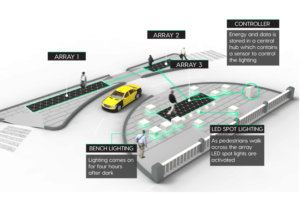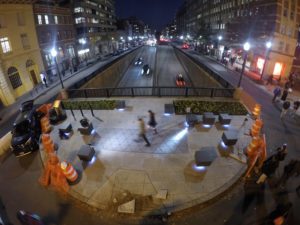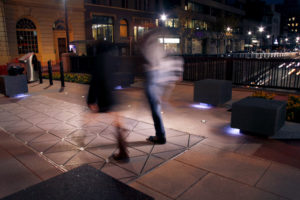Step Out for Cleaner Energy by Walking On It

Great headline from FutureStructure: “Kinetic Tiles Bring New Meaning to Power Walk”
See it at DuPont Circle in Washington, DC. Try it there. Or, maybe you walk over it regularly since its dedication last month?


Just completed is the installation of high-tech, “springy” walking tiles built to transfer kinetic energy from their movement to 68 “generators.” These in turn power interactive light installations in the “Connecticut Avenue Overlook Parklet,” a newly built plaza in always-trendy DuPont Circle. They will also power LED lighting mounted below granite box seats arrayed in the plaza and bordered by landscaped beds.
Thousands of commuters now walk or scurry across the Pavegen installation in the parklet on a daily basis. Any flickering of the lights will likely be due to an insufficient number of walkers. The technology is proved elsewhere, including on London Bridge in England. (My last post about harnessed kinetic energy, here, featured innovative automobile manufacture. Scroll down the page for it.)
What does it feel like? One description- somewhat stiffer than AstroTurf. “Step on the tiles,” offers Forbes contributor Hilary Brueck, “and suddenly you’re literally a powerhouse of 5 watts – about as good as a standard iPhone charger.”
“The glass-reinforced-plastic triangles are stitched together in the sidewalk like an M.C. Escher painting, with the corners balancing on a silver connector tied to generators below,” writes nascent artistic advisor and Washington Post contributor Michael Laris. “The force of a footstep slightly depresses the corners, which accounts for the little wiggle while people walk. The downward force spins a flywheel, complete with magnets and copper, generating the juice.”
Walkers immediately benefit from their strides as small white lights framing the tiled pathways light up. With storage batteries in place, “the remainder of the energy will be used to power the lights in the plaza.” Duration? About 6 hours before more striding commuters are needed to recharge the grid.
The technology is called “footfall energy-harvesting.” “It’s just a dumb tile,” says CEO/founder Laurence Kemball-Cook. “When you walk on it, that’s when it gets smart.”
The cost? Astronomical for the time being. Kemball-Cook says he aims to bring the cost in line with typical flooring within a couple of years. Cool that an effort at crowdsource funding has had a positive financial impact on the product’s development.


(All photos: Pavegen)